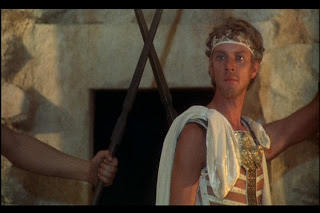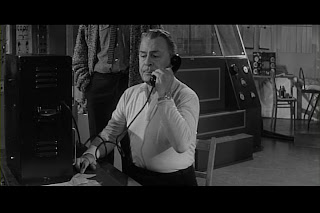
Featuring scenes of mind-numbing cruelty and sexual debauchery existing in equal measure with interminable scenes of inert dramatics, Caligula finds its way to DVD this October 2nd, replacing Image’s long out of print edition with not one, not two, but three different editions. The most comprehensive - a 3-disc set titled The Imperial Edition – features 2 slightly different cuts of the film, 3 commentary tracks, hours upon hours of “deleted scenes”, the full length version of a vintage documentary, and even PDF files of photo layouts as they originally appeared in Penthouse. Did I forget to mention that the film was financed by Penthouse publisher Bob Guccione?
Maybe I should back up a bit…
Using a script by Gore Vidal (who had every intention of supervising the production) and his magazine’s millions, the Guccione managed to secure the services of several top tier British actors, including Malcolm McDowell as Caligula, Helen Mirren as his wife, Caesonia, with Peter O’Toole and John Gielgud top-lining in smaller roles. After seeing Salon Kitty, Guccione immediately hired director Tinto Brass to helm Caligula, but Brass didn’t get on with Vidal at all, and as shooting commenced in 1976, the author found himself on the outside looking in and not liking what he saw one bit.
It would actually be nearly three years before an unfinished print was shown at the ’79 Cannes festival, and almost another full year before its infamous New York premier, where the film was shown only at the Penthouse East Cinemas (yes, you read that right) and charged $7.50 for tickets - nearly doubling the average admission price. But the rumors of astounding violence and scenes of hardcore sex had been running wild, and people had to see for themselves. Were these elder statesmen (and women) of British stage & screen really participating in a $17 million (that’s approximately $60 million inflation-adjusted dollars) porno epic? Well, they were!
…and they weren’t.
Maybe I should back up a bit…
When principal photography was completed, Guccione took over editing and locked Brass out. Brass joined the fray of lawsuits that plagued the film for the next few years, and Guccione, not satisfied with the simulated softcore sex shot by Brass, brought in some Penthouse Pets and a couple dozen broad-minded Italian extras for another round of filming. Only this time, it was explicit hardcore footage. When the actors who had appeared in the film got wind of what Guccione was up to, they took him and the film apart in the press. McDowell famously blasted the film on a French chat show and implored the viewing audience to avoid it, but the damage to the reputation of the actors was done. While they knowingly signed up for a film that would be sexually explicit, there was never a question of actual sex being involved. But when the background is filled with nymphs and satyrs rutting each other with jewel encrusted cod pieces, it is difficult to claim that you had no idea what sort of film you were making. O’Toole and Gielgud escaped largely unharmed, due mostly to their limited screentime. McDowell and Mirren weren’t as lucky, and after “that porno” arrived in theaters in 1980, McDowell found himself in less and less prestigious projects. He’s always worked, but that’s mostly because he says ‘yes’ to everything. And without a strong director to guide him, McDowell reverts to the kind of eye-bulging, mustache twirling business that only a RADA-trained actor is capable of. Stardom would elude Helen Mirren for several decades more, but a late career run of higher profile projects culminated in an Academy Award earlier this year for The Queen. Caligula ended Tinto Brass’ flirtation with the European art house market, but continues to make superior erotic films in his native Italy to this very day. Guccione took the considerable profits from Caligula and sunk them into a Penthouse Casino. Neither the casino nor the money was ever seen again.

And the film itself? It’s rather incredible for Guccione to have spent all these millions only to wind up with such an ugly, unpleasant film to look at. It’s difficult to say how differently the film would have looked if Brass were allowed to supervise the editing – the final product is so amateurish – but in its finished form it appears as if the action was never blocked for the camera beforehand. Every scene is simply hosed down with zoom lenses that frantically dart around the sets attempting to capture the actors. The stunning (and massive) sets by the great Danilo Donati are simply lost to the chaos. Guccione certainly got his money’s worth with McDowell; he throws himself into the role with complete abandon, and no small amount of courage. He prances around like a mad peacock, obviously aware that subtlety has no reservation at this hotel. The other actors don’t fare as well; no performance in the film seems remotely seems remotely connected to another. This is a common problem with any large multinational production where the actors and crew speak different languages, but it is much more acutely felt here.

The previous DVD from Penthouse and Image has been fetching high prices on EBay, in spite of a non-anamorphic, seriously unattractive image. The “high definition transfer” image on the new Imperial Edition is likely to raise expectations far beyond what the transfer can offer. The garish lighting and poor print quality will always play hell with any home video presentation of the film - short of a major restoration of the original, this is probably the best that the film will look. Disc 1 contains the unrated theatrical edition and disc 2 contains an odd hybrid that is being called a “pre release version”. It’s not the 210min whopper from Cannes, it’s basically the same version as o n disc 1, with most (though not quite all) the hardcore sex removed. Sadly, instead of just allowing the film to run shorter, it replaces all the X footage with long takes of incidental, background action. The considerable violence also survives intact. The eagerly awaited commentary tracks are on the pre release version, and they are by far the most enjoyable extras. McDowell’s track is lively and fun; since he’s is on screen for at least 95% of the film, and was privy to much of the back-stage machinations. And though obviously aware of the absurdity of the film, he does mention how proud of his own work and that of the many other actors and craftsmen who really did set out to do something special. His deadpan reaction upon spotting a farm animal during an orgy sequence is also priceless. Mirren was on set much less than McDowell, but like her co-star she is generous with praise and a bit sad at how it all turned out. The third track is with Ernest Volkman, an journalist who was covering the film for Penthouse. His track is also quite interesting, though he literally phones in his commentary – the first time I’ve ever heard of this happening on a commentary track for the entire duration of the film.

Disc 2 also features “hours of deleted and extended scenes”. While technically true, it is a bit misleading as most of these are just rushes (all silent) or occasions where the cameras were rolling while the actors were finding their marks and preparing for a take. There are definitely a few interesting odds and ends, including a very different, and much improved, ending to the famous “head chopper” execution scene. Disc 3 contains the hour long version of the Making of Caligula, made so early during production, that it features Gore Vidal telling us all what a treat we’re in for when filming is completed, along with a contemporary interview with Brass, and assorted ephemera.

Is Caligula a good film? No – not even close. But it is an incredibly interesting one; a film that could only have been made in the late 70s when it seemed that the adult film industry and Hollywood were headed for a collision. Porn starlet Andrea True had a disco smash with “More, More, More”, Harry Reems was being feted by Warren Beatty and Jack Nicholson to raise money for his defense fund, and Jackie O was photographed leaving a showing of Deep Throat. Would films like Caligula and the explicit Last Tango in Paris be the bridge between the two worlds? That particular dream was over when video tape ghettoized porn by putting the entire industry on the cheap, but thanks to Image Entertainment, yet another generation will witness what happened when the West End met the ‘Duce.







 Top lined by Al Hedison (the film came before his studio imposed name change to ‘David’, doubtlessly giving the actor many frustrating years of “I loved your brother in The Fly”) and Patricia Owens as the doomed Delambres, and much rests on their shoulders. Vincent Price, whose image would be most closely associated with the film in decades to come, and Herbert Marshall (as François and Charas, respectively) were far better known to audiences and gave the film a dose of gravitas; but it’s Hedison and Owens who have to carry the film. The role of Andre was turned down by many better known actors (including The Day the Earth Stood Still’s Michael Rennie) who balked at spending a large part of post botched-experiment screen time with their head first under a shroud, and then covered in ace makeup man Ben Nye’s stunning fly mask, but then-newcomer Hedison wisely jumped at the opportunity. Hedison cemented his genre credentials with the TV adaptation of Voyage to the Bottom of the Sea 6 years later, and has enjoyed a very active career ever since. Co-star Owens’ career never took off, despite her ear-piercing reaction to her husband’s mutation quickly becoming one of the most iconic horror images of all time.
Top lined by Al Hedison (the film came before his studio imposed name change to ‘David’, doubtlessly giving the actor many frustrating years of “I loved your brother in The Fly”) and Patricia Owens as the doomed Delambres, and much rests on their shoulders. Vincent Price, whose image would be most closely associated with the film in decades to come, and Herbert Marshall (as François and Charas, respectively) were far better known to audiences and gave the film a dose of gravitas; but it’s Hedison and Owens who have to carry the film. The role of Andre was turned down by many better known actors (including The Day the Earth Stood Still’s Michael Rennie) who balked at spending a large part of post botched-experiment screen time with their head first under a shroud, and then covered in ace makeup man Ben Nye’s stunning fly mask, but then-newcomer Hedison wisely jumped at the opportunity. Hedison cemented his genre credentials with the TV adaptation of Voyage to the Bottom of the Sea 6 years later, and has enjoyed a very active career ever since. Co-star Owens’ career never took off, despite her ear-piercing reaction to her husband’s mutation quickly becoming one of the most iconic horror images of all time. 








